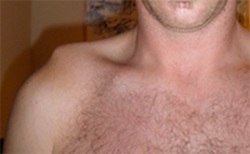Initial symptoms

An acute shoulder separation usually results from a direct fall on the point of the shoulder. This severe direct force on the supporting ligaments of the AC joint causes these ligaments to fail resulting in a separation of the AC joint. In severe cases, both the acromioclavicular ligaments as well as the coracoclavicular ligaments are ruptured and there is an immediate deformity that occurs. Without surgery this deformity remains permanent as the entire weight of the arm continues to pull the scapula down and forward. Although it appears as though the end of the clavicle is the problems because it is protruding (as seen in the photograph) it is actually the abnormal position of the scapula that is pulling the arm away from the clavicle. Depending on the severity of the injury this deformity can be quit dramatic as the joint can be pulled down as much as two inches. The deformity can only be corrected by lifting up the scapula and holding it in place as demonstrated in this clinical video. Pushing down on the clavicle would be ineffective as the clavicle is actually in its normal position! Initially the primary symptoms of this injury are pain, deformity, and weakness.
Complete AC Joint Separation (Grades 3,4,5, and 6) – Late symptoms
After the symptoms of the initial trauma subside many patients will go on to have pain-free and satisfactory function of the shoulder, although the deformity will always be present. In a substantial percentage of cases, however, the mismatch of the joint will create ongoing and disabling symptoms. This includes localized pain, painful clicking and popping, and shoulder fatigue. High demand patients such as those involved in manual labor, repetitive tasks or athletes may notice either a generalized weakness or lack of endurance. While physical therapy may overcome some of these symptoms, the permanent derangement of the anatomy leaves the shoulder function compromised for many patients.
Stable or incomplete separation (types 1 and 2)
In less severe case the anatomy is left either somewhat (type 2) or completely (type 1) intact. Any amount of deformity even in incomplete ruptures will be permanent for the reasons mentioned above. Pain can be quite severe even in cases with little deformity; however, simple treatment with a sling for comfort, ice, rest, and early rehab will result in resolution in most cases.
In some cases of incomplete separation or even in cases with normal x-rays (Type 1 or Type 2) there can be persistent symptoms. The initial impact may cause cell death of the articulating cartilage of the joint causing late breakdown of cartilage tissue. This type of traumatically induced arthritis can cause chronic pain and require surgical treatment in rare cases.
Fortunately, a repair or reconstruction is rarely indicated and a simple debridement of the end of the clavicle will reproducibly resolve these symptoms.




